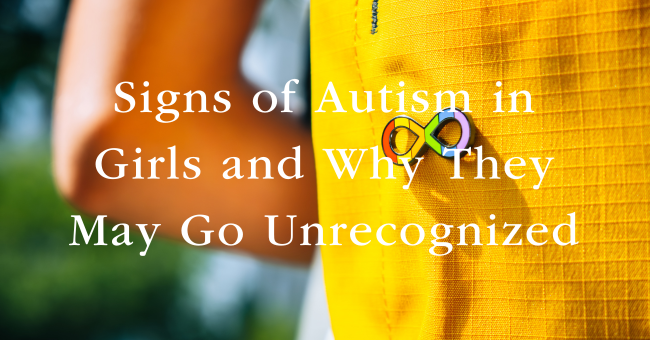 Draven Jackson
Draven Jackson
Blogger | Teacher
Twitter
Despite how far medical understanding has come in recent years, we are still learning a lot about the Autism Spectrum, especially about girls and women. Oftentimes, autism in girls is overlooked or unrecognized. This has a lot to do with how we view autism and signs of autism – i.e., through a male-centric lens. Because autism, like ADHD, often looks different in girls, it can be difficult for young girls to get a proper diagnosis. If you have ever wondered about whether you, as a woman, might have undiagnosed autism – or maybe you have a little girl in your life who is exhibiting some of the signs and traits below – I hope this article can help you.
I want to start by saying that I am not a professional nor a healthcare provider, so I am in no way qualified to state whether someone is autistic or not. However, in recent years I have had the pleasure of meeting a diverse community of women, trans men, and nonbinary people – many of whom have been assessed for autism and have received an autism diagnosis – and they have helped me to better understand the struggles they went through both before and after their diagnosis. Because of this, I have learned about the importance of being aware of the signs and traits of autism, especially those that are often overlooked or unrecognized, so that I can better support the people around me.
*Also, as a note, this article will be using the terms “girl/woman” in place of “female,” the word commonly used to discuss biological sex. As I have learned, many of these signs, traits, and struggles have also proven to be relevant to trans or non-binary autistic people, so the signs and traits listed may be experienced by a diverse group of people. Also, the term “autistic people” will be used in place of “people with autism” as it follows Identity-First Language, which is preferred by many on the spectrum.
Signs of Autism in Girls/Women
Stimming
 A common sign of autism in girls is stimming, or self-stimulating behavior. Stimming usually involves repetitive motions or sounds that help someone who may have autism regulate their emotions. While people without autism can also stim – for example, tapping your finger or shaking your leg can be signs of boredom or anxiety in someone who does not have autism – autistic people stim if they are having issues with sensory overload.
A common sign of autism in girls is stimming, or self-stimulating behavior. Stimming usually involves repetitive motions or sounds that help someone who may have autism regulate their emotions. While people without autism can also stim – for example, tapping your finger or shaking your leg can be signs of boredom or anxiety in someone who does not have autism – autistic people stim if they are having issues with sensory overload.
Some examples of stimming include tapping fingers together, rocking back and forth, humming, heavy blinking, snapping fingers, covering/uncovering ears, bouncing in place, and hand-flapping. People may stim differently and in a variety of ways, so pay attention to the situations you or your child may be experiencing when stimming occurs.
Difficulty Dealing with Strong Emotions
Autism in girls can also often mean difficulty in dealing with strong emotions. This is often referred to as “emotion dysregulation,” which can result in emotional outbursts known as “autistic meltdowns.” These can happen at seemingly random moments – despite being happy earlier in the day, it can be easy for negative or intrusive thoughts to take over and lead to feelings of discomfort, imbalance, and shutdown.
Many adults who did not receive an autism diagnosis until they were well into adulthood might frequently feel anxious, depressed, or exhausted due to having to force themselves to mask or regulate their emotions all day throughout their lives. While there is a large crossover of autism with various mental health conditions (like anxiety or OCD), those anxious or depressed feelings may also be from shutdown or emotion dysregulation.
Hyperfixating on Special Interests
A common sign of autism in girls is a small list of interests or intense hyperfixation on special interests. An autistic person may be able to focus very deeply on one specific topic or interest, but will have a more difficult time connecting with things that do not interest them. For example, my friend (an autistic woman) can talk for hours about her favorite video game or K-pop group, but she will quickly become uninterested in topics that she doesn’t know much about.
Hyperfixating means that many autistic people are incredibly well-informed and passionate about their special interests, but it can be difficult for them to split their attention on multiple topics or follow conversations that hop from one topic to the next too quickly.
Problems Communicating or Interacting in Social Settings
Many times, autism in girls is written off as a child being “quiet” or “shy” because the autistic child in question can have a harder time jumping into conversations with the children around them or responding in class. Many autistic traits in girls that have to do with social interactions or communication are overlooked as “personality traits,” but many times autistic girls may have trouble picking up on various social cues or don’t understand statements that are too vague. Autism can also result in audio processing issues, so it may take more time for an autistic person to process a comment and respond to it, leading to some issues or delays in social interactions.
To better “mask” and blend in with the other girls around them, autistic girls may choose to be silent or withdrawn in situations where they don’t understand the conversation or don’t know what to say. And because oftentimes girls are expected to be quieter or more passive than boys, these signs of autism are overlooked entirely.
Eye Contact
Similar to boys, autism in girls can result in stress concerning eye contact. Autistic people find it difficult to maintain eye contact with others based on a few different factors. One reason is that it is difficult for autistic people to concentrate on what someone is saying while also looking at their eyes, which can lead them to feel overwhelmed or uncomfortable during the interaction.
Not to mention, autistic adults have described eye contact as being painful, with the possible side effects of trying to maintain it including dizziness, tremors, and headaches. It can also feel confusing, intense, or even invasive to some.
Why These Signs Go Unrecognized
Girls/Women Tend to Mask Their Autistic Traits
From a young age, autistic girls learn to mask their autistic traits to appear more “normal.” “Masking” is the act of suppressing or controlling certain behaviors to better fit into society. For example, while a lack of eye contact is one of the many criteria used for an autism test, it can be difficult to use this marker with women. Many girls learn early on that eye contact is important for “normal” conversations, so they suppress their internal discomfort and force themselves to make eye contact so that they can fit in.
Masking is incredibly uncomfortable and can lead to a lot of problems for autistic women down the road. Because they are suppressing their body’s feelings and natural responses to different situations, they can’t properly take care of their physical or mental health. By supporting autistic women to be themselves and not adhere to societal expectations, you can help them feel more comfortable and relaxed in their environments.
Many Signs are Often Misattributed
As I mentioned, there is a large crossover between autism and mental health conditions, which can lead to an autism diagnosis being misattributed as something else. It is also possible that an autistic person may have comorbidities, meaning their autism exists alongside something else (like ADHD or anxiety). This can lead to confusion in parents or caregivers as to whether a certain trait is autism or not.
Regardless of the existence of other conditions, it is important for autistic people to get the correct diagnosis so that they can learn how to take care of themselves and their needs best.
Most of the Research on Autism is focused on Boys/Men
One of the biggest issues autistic girls and women face is that most of the autism research is focused on boys or men. Because symptoms and signs of autism show up differently based on gender, often autism in girls is overlooked as a personality trait rather than an actual sign of autism. Even healthcare providers may miss an autism diagnosis in girls because the existing criteria are based primarily on research done on boys or men.
Autism does not exist only in boys and men, and it’s important to listen when the little girls in your life are showing you possible signs. We need to improve our understanding and knowledge about autism to help and support the autistic people around us. These are not the only signs of autism in girls – there are plenty more that autistic people everywhere might experience, such as problems regulating temperature, textural issues, or executive dysfunction – so if you want to find out more, there are so many free resources available online that could you help gain a better understanding of what autism might look like for you and the people in your life!
I hope, in the future, we can create a society where people can feel comfortable in their own skin and can talk openly and honestly about what they need.
 About Draven Jackson
About Draven Jackson
Draven is an avid writer and reader who enjoys sharing her opinions on movies, books, and music with the rest of the world. She will soon be working as a teacher in Japan and hopes to use her experience to connect with other teachers and students around the globe. Draven spends most of her time at home with her family, her dogs, and her ferret.
To see more, view all posts by Draven Jackson here.
Save






6 Comments on “Signs of Autism in Girls and Why They May Go Unrecognized”
Recognizing signs of autism in girls is crucial. This informative article highlights often overlooked symptoms, aiding early intervention and support.
So much great information for us parents & a lot of I never knew. Thanks for the great article!
I often have wondered if I might have undiagnosed autism, along with ADHD (which my youngest child has). Some of these symptoms (ex. The being labeled as quiet/shy) definitely apply to me and I have often felt socially awkward. I guess a goal this year is to get to a doctor who can help me better look into these concerns and determine if there is any validity to them. Thanks for writing this and helping me think more about this!
Quite interesting and informative, I have an 8 year old daughter who exhibits one or two signs but never even crossed my mind that that would be a possible reason.
Thank you for this great information.
My son has high functioning autism so I know what to look for but really useful info for people who don’t know